Kyzyl
Kyzyl (Tuvan and Russian: Кызыл, romanized: Kızıl) is the capital city of the Tuva Republic, Russia. The name of the city means "red" or "crimson" in Tuvan (as well as in many other Turkic languages). Population: 109,918 (2010 Census);[3] 104,105 (2002 Census);[8] 84,641 (1989 Census).[9]
Kyzyl
Кызы́л | |
|---|---|
City[1] | |
| Other transcription(s) | |
| • Tuvan | Кызыл |
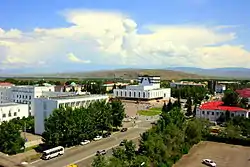 The "Center of Asia" monument in Kyzyl | |
.png.webp) Flag  Coat of arms | |
Location of Kyzyl 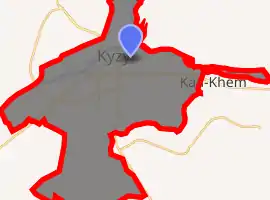
| |
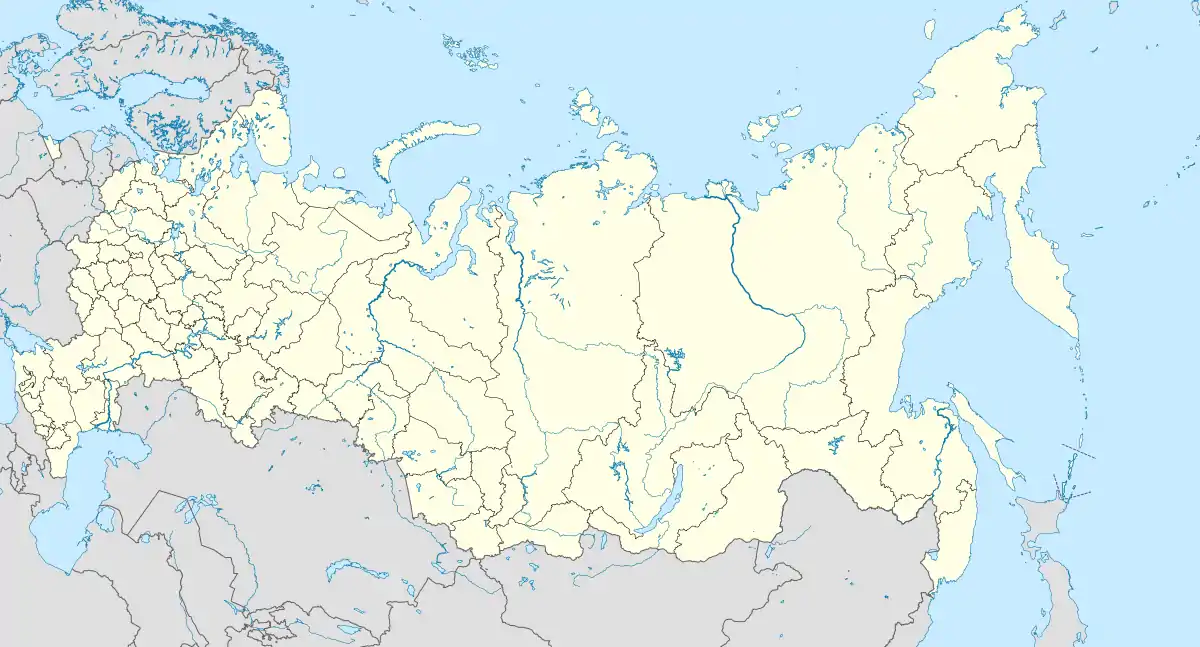 Kyzyl Location of Kyzyl 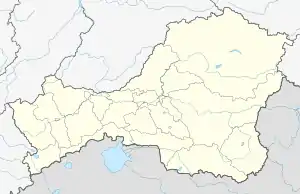 Kyzyl Kyzyl (Tuva Republic) | |
| Coordinates: 51°43′N 94°27′E | |
| Country | Russia |
| Federal subject | Tuva[1] |
| Founded | 1914 |
| City status since | 1914 |
| Government | |
| • Mayor | Dina Oyun[2] |
| Elevation | 630 m (2,070 ft) |
| Population | |
| • Total | 109,918 |
| • Estimate (2018)[4] | 116,983 (+6.4%) |
| • Rank | 146th in 2010 |
| • Subordinated to | city under republic jurisdiction (urban okrug) of Kyzyl[1] |
| • Capital of | Tuva Republic[1] |
| • Capital of | city under republic jurisdiction (urban okrug) of Kyzyl[1] |
| • Urban okrug | Kyzyl Urban Okrug[5] |
| • Capital of | Kyzyl Urban Okrug[5] |
| Time zone | UTC+7 (MSK+4 |
| Postal code(s)[7] | 667000–667005, 667007–667012, 667700, 667899, 667961, 667965, 667966, 667970, 667999 |
| Dialing code(s) | +7 39422 |
| OKTMO ID | 93701000001 |
| Website | mkyzyl |
It was previously known as Belotsarsk (until 1918), Khem-Beldyr (until 1926).
History
It was founded in 1914 as Belotsarsk (Белоца́рск, lit. White Tsar's town).[10] In 1918, it was renamed Khem-Beldir (Хем-Белдир), and in 1926 it was given its present name. When the city was the capital of Tannu Tuva, it was named Kizil Khoto. In September 2014, Kyzyl celebrated its 100th anniversary as a city.
| Years | Titles | Affiliation |
|---|---|---|
| 1914-1917 | Belotzarsk | Uryankhai Territory (protectorate |
| 1921-1944 | Hem-Beldyr, Kyzyl | (partially recognized state) |
| 1944-1991 | Kyzyl | |
| since 1991 | Kyzyl |
The settlement was founded in 1914 by Russian settlers immediately after the entry of the then Uryanhai Territory under the protectorate of the Russian Empire called Belotsarsk .
In the center of the Uryankhai region, at the confluence of the two Yenisei, the Big and Small, on a large elevated plain, I have designed the administrative center of the region, the future city of Belottsarsk. This name was given in honor of the Sovereign Leader of the Russian people, known to the Uryankhs under the name "Tsagan-Khan", which means White Tsar ...
— Vladimir Gabaev, head of the Russian population in Tuva [11]
In 1918, in connection with the revolution and the antimonarchist movement, it was renamed to Khem-Beldyr, and in 1926 to Kyzyl ( Tuv .: red ).
In 1921-1944, the city was the capital of Tuvan People's Republic.
Since 1944 - Tuva Autonomous Oblast RSFSR, since 1961 - Tuva ASSR and since 1991 - Republic of Tyva.
They began to lay a new city in the village of Vilany, in Tuvan - Khem-Beldyr, which means “confluence of rivers”. Technological engineer K.V. Goguntsov and topographer M. Ya. Kryuchkov arrived here in February 1914. Kryuchkov drew a general plan of the city of Belotsarsk (fund 123, opis, 2, delo 21), which basically coincides with the plan of the central part of the city of Kyzyl. The city plan shows the numbers of the land plots and gives an explanation of who owns these plots. In May 1914, the head of the Russian population in Uryankhai approved the draft rules on the allotment of land plots and the organization of a committee for the improvement of the future city. The very first plots were allocated for houses of officials, administration, for honorary Uryankhs, treasury, post and telegraph office, state fire shed.
The city was built by recruited workers from Krasnoyarsk, Minusinsk, Tomsk and other cities of Siberia, Tuvan farm laborers, Russian workers who fled from gold mines because of difficult working and living conditions.
On July 4, 1915, the Commissioner for the Uryankhai Territory V. Yu. Grigoriev wrote a letter to the Head of the Russian population in the Uryankhai Territory, where the very important issue of creating a museum in the city of Belotsarsk was raised (fund 123, inventory 2, file 53, sheets 25-26).[12][13]
At the IV Uryankhai regional congress on March 11, 1918, a decree was issued to rename Belottsarsk to Uryankhaisk. However, this name did not stick to the city, it was still called White Tsarsky.
The revolutionary events of 1917 in Russia did not pass by the new capital of Tuva. During a major battle (the White Tsarsky battle) between the red partisans of the detachment of P.E.Schetinkin and A.D. Kravchenko and the Kolchak men under the command of the captain G.K.Bologov at the end of August 1919, the city was almost completely burned down. The 10th congress of representatives of the Russian population of Tuva (September 16-20, 1920) gathered in the village of Turan, Uryankhai region. At this congress it was decided to restore the city and rename it the Red City.
On August 13, 1921, in the town of Sug-Bazhy (the village of Kochetovo), the Vsetuvinsky Constituent Khural of representatives of all khoshuns (khoshun was an administrative-territorial unit of that time) of Tuva gathered. Khural proclaimed the creation of an independent state - the Tuvan People's Republic. In March 1922, the Tuvan government, the Central Committee of the Tuvan People's Revolutionary Party (Central Committee of the TNRP), and the Executive Committee of the Russian Self-Governing Labor Colony (RSTK) were transferred to the restored Kyzyl. In the spring of 1922, the city of Kyzyl became the capital of the Tuva People's Republic (TNR).
In 1924, the Tuvan Central Cooperative (Tuvintsenkoop, TCC) was formed, which played a significant role in the development of industrial production, domestic and foreign trade. In 1925, the Tuvan National Bank (Tuvinbank) began its activity, which contributed to the development of all sectors of the national economy. In Kyzyl, enterprises for the processing of agricultural raw materials were organized, in 1928 a shoemaker's workshop was opened, in 1930-1931 - a sausage workshop, a pimokatny and tailoring workshop. In the early 1940s, a mill, a sawmill, a power station and a brick factory operated in Kyzyl, and sheepskin and fur production was organized. In 1929 the Kyzyl printing house was opened, the transport organization "Soyuztrans" was created. From that moment, the beginning of the development of the transport of the Tuvan People's Republic was laid. Two years later, the truck fleet consisted of 31 vehicles. In 1931, a telephone exchange for 30 subscribers was opened in the city of Kyzyl.[14]
Geography
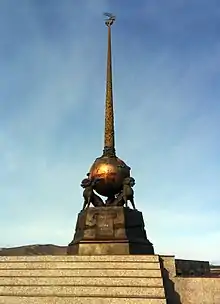
Kyzyl claims to be located exactly in the geographical center of Asia. Whether these coordinates are in fact the center of Asia is disputed (e.g., Ürümqi in China makes a similar claim). However, there is a monument labelled "Center of Asia" in English, Russian, and Tuvan which asserts this claim. Tos-Bulak is the area of open fields and mineral springs which lies immediately south of Kyzyl.
Kyzyl stands at the point where the Yenisei River meets the Maly Yenisey River to form the Verkhny Yenisey[15] (Улуг-Хем). Most development takes place south of the river and follows the curves of the river, with the highest development centered where the two headstreams of the Yenisei, the Bii-Khem (Russian: Большой Енисей), and the Kaa-Khem (Russian: Малый Енисей, romanized: Maly Yenisei), meet. A monument was built in 1964 on the river bank to mark this.
Administrative and municipal status
Kyzyl is the capital of the republic.[1] Within the framework of administrative divisions, it is incorporated as the city under republic jurisdiction (urban okrug) of Kyzyl—an administrative unit with the status equal to that of the districts (kozhuuns).[1] As a municipal division, the city under republic jurisdiction (urban okrug) of Kyzyl is incorporated as Kyzyl Urban Okrug.[5]
Industry
Manufacturing plants include brickyards, sawmills, furniture manufacturing, and food-processing plants.[16]
Transportation
The city is served by the Kyzyl Airport.
There is a project of the Tuvan Railway with a railway terminal in Kyzyl. The construction must be finished in 2020.
Architecture
Buildings of cultural and political importance in Kyzyl include the Tuvan Parliament building, the National Theater, and a Khoomei center (officially, the International Scientific Center "Khoomei") dedicated to studying and teaching khoomei, Tuvan throatsinging.
 Kyzyl Theatre and prayer wheel
Kyzyl Theatre and prayer wheel Monument "Khaan and Kadyn are hunting" near to the monument "The Center of Asia"
Monument "Khaan and Kadyn are hunting" near to the monument "The Center of Asia"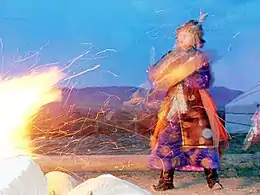 Shaman dancing near Kyzyl
Shaman dancing near Kyzyl
Education
- School No. 1 (Kyzyl) – first school in the city.[17]
- Tyvan State University – is the only university in Tyva.
Climate
The climate of Kyzyl is an extreme continental semi-arid variety (Köppen climate classification BSk), with average highs around 25 °C or 77 °F in the summer and −20 °C or −4 °F in the winter and only 218 millimetres or 8.58 inches of precipitation annually. Located far from any moderating bodies of water and at a relatively high latitude, temperatures can be extreme, though less so than the Sakha Republic. Nevertheless, the temperature has never risen above freezing from 22 November to 3 March, inclusive. Temperature swings can be rapid. The transitional seasons of spring and autumn are short: only April and October average close to the annual mean of −1.2 °C (29.8 °F).
| Climate data for Kyzyl | |||||||||||||
|---|---|---|---|---|---|---|---|---|---|---|---|---|---|
| Month | Jan | Feb | Mar | Apr | May | Jun | Jul | Aug | Sep | Oct | Nov | Dec | Year |
| Record high °C (°F) | −5.8 (21.6) |
−0.1 (31.8) |
19.6 (67.3) |
30.6 (87.1) |
35.6 (96.1) |
39.1 (102.4) |
40.7 (105.3) |
38.3 (100.9) |
33.0 (91.4) |
23.0 (73.4) |
13.0 (55.4) |
−1.8 (28.8) |
40.7 (105.3) |
| Average high °C (°F) | −23.5 (−10.3) |
−16.1 (3.0) |
−2.8 (27.0) |
12.4 (54.3) |
20.9 (69.6) |
25.8 (78.4) |
27.6 (81.7) |
24.9 (76.8) |
18.0 (64.4) |
8.3 (46.9) |
−7.8 (18.0) |
−20.5 (−4.9) |
5.6 (42.1) |
| Daily mean °C (°F) | −28.7 (−19.7) |
−23.5 (−10.3) |
−10.2 (13.6) |
4.7 (40.5) |
12.8 (55.0) |
18.2 (64.8) |
20.5 (68.9) |
17.6 (63.7) |
10.4 (50.7) |
1.2 (34.2) |
−12.9 (8.8) |
−24.9 (−12.8) |
−1.2 (29.8) |
| Average low °C (°F) | −33.0 (−27.4) |
−29.4 (−20.9) |
−16.7 (1.9) |
−2.0 (28.4) |
5.1 (41.2) |
11.2 (52.2) |
14.2 (57.6) |
11.3 (52.3) |
4.2 (39.6) |
−4.3 (24.3) |
−17.2 (1.0) |
−29.0 (−20.2) |
−7.1 (19.2) |
| Record low °C (°F) | −52.6 (−62.7) |
−54.0 (−65.2) |
−45.2 (−49.4) |
−27.3 (−17.1) |
−10.7 (12.7) |
−1.8 (28.8) |
2.8 (37.0) |
−0.7 (30.7) |
−10.1 (13.8) |
−20.5 (−4.9) |
−46.1 (−51.0) |
−52.6 (−62.7) |
−54.0 (−65.2) |
| Average precipitation mm (inches) | 8.7 (0.34) |
4.5 (0.18) |
3.1 (0.12) |
5.1 (0.20) |
13.4 (0.53) |
34.6 (1.36) |
48.5 (1.91) |
43.5 (1.71) |
24.7 (0.97) |
8.8 (0.35) |
11.6 (0.46) |
11.4 (0.45) |
217.9 (8.58) |
| Average rainy days | 0 | 0 | 0 | 6 | 11 | 15 | 16 | 15 | 12 | 6 | 1 | 0 | 82 |
| Average snowy days | 21 | 17 | 9 | 3 | 1 | 0 | 0 | 0 | 0.2 | 4 | 16 | 23 | 94 |
| Average relative humidity (%) | 79 | 78 | 74 | 48 | 43 | 50 | 58 | 62 | 63 | 67 | 81 | 81 | 65 |
| Mean monthly sunshine hours | 81.8 | 127.8 | 213.1 | 247.8 | 288.2 | 295.9 | 287.5 | 274.7 | 228.1 | 167.4 | 83.9 | 57.3 | 2,353.4 |
| Source 1: Pogoda.ru.net[18] | |||||||||||||
| Source 2: Weatherbase (precipitation and sun data)[19] | |||||||||||||
| Kyzyl | ||||||||||||||||||||||||||||||||||||||||||||||||||||||||||||
|---|---|---|---|---|---|---|---|---|---|---|---|---|---|---|---|---|---|---|---|---|---|---|---|---|---|---|---|---|---|---|---|---|---|---|---|---|---|---|---|---|---|---|---|---|---|---|---|---|---|---|---|---|---|---|---|---|---|---|---|---|
| Climate chart (explanation) | ||||||||||||||||||||||||||||||||||||||||||||||||||||||||||||
| ||||||||||||||||||||||||||||||||||||||||||||||||||||||||||||
| ||||||||||||||||||||||||||||||||||||||||||||||||||||||||||||
In popular culture
In the late 1980s, Kyzyl was visited by Ralph Leighton, who had made it a quest to reach Tuva with his friend, the Nobel Prize-winning physicist Richard Feynman. Though Feynman died before they reached Tuva, the journey is chronicled in the book Tuva or Bust!
The film Genghis Blues chronicles the pilgrimage of a blind blues performer, Paul Pena, who learned Tuvan throat singing by listening to his shortwave radio, to compete in the Tuvan throat singing competition.
Kyzyl is featured as a cultural city-state in the strategy game Civilization V.
Sister cities
 Honolulu, Hawaii, United States[20]
Honolulu, Hawaii, United States[20]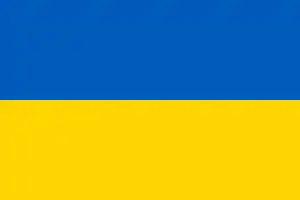 Rivne, Ukraine
Rivne, Ukraine Cuiabá, Mato Grosso, Brazil (both cities are claimed to be located in the exact center of their respective continents)
Cuiabá, Mato Grosso, Brazil (both cities are claimed to be located in the exact center of their respective continents)
References
Notes
- Resolution #1648 ZP-1
- 667001, ИА Тува-Онлайн; Россия; Кызыл, город; Калинина, улица; 10, Д.; http://www.tuvaonline.ru, к 66 Интернет-порталы +7350-45-77. "Mayor of Kyzyl Dina Oyun took part in the World Summit of Local and Regional Leaders in Bogota". Tuva-Online. Retrieved February 10, 2017.CS1 maint: numeric names: authors list (link)
- Russian Federal State Statistics Service (2011). "Всероссийская перепись населения 2010 года. Том 1" [2010 All-Russian Population Census, vol. 1]. Всероссийская перепись населения 2010 года [2010 All-Russia Population Census] (in Russian). Federal State Statistics Service.
- "26. Численность постоянного населения Российской Федерации по муниципальным образованиям на 1 января 2018 года". Federal State Statistics Service. Retrieved January 23, 2019.
- Law #268 VKh-1
- "Об исчислении времени". Официальный интернет-портал правовой информации (in Russian). June 3, 2011. Retrieved January 19, 2019.
- Почта России. Информационно-вычислительный центр ОАСУ РПО. (Russian Post). Поиск объектов почтовой связи (Postal Objects Search) (in Russian)
- Russian Federal State Statistics Service (May 21, 2004). "Численность населения России, субъектов Российской Федерации в составе федеральных округов, районов, городских поселений, сельских населённых пунктов – районных центров и сельских населённых пунктов с населением 3 тысячи и более человек" [Population of Russia, Its Federal Districts, Federal Subjects, Districts, Urban Localities, Rural Localities—Administrative Centers, and Rural Localities with Population of Over 3,000] (XLS). Всероссийская перепись населения 2002 года [All-Russia Population Census of 2002] (in Russian).
- "Всесоюзная перепись населения 1989 г. Численность наличного населения союзных и автономных республик, автономных областей и округов, краёв, областей, районов, городских поселений и сёл-райцентров" [All Union Population Census of 1989: Present Population of Union and Autonomous Republics, Autonomous Oblasts and Okrugs, Krais, Oblasts, Districts, Urban Settlements, and Villages Serving as District Administrative Centers]. Всесоюзная перепись населения 1989 года [All-Union Population Census of 1989] (in Russian). Институт демографии Национального исследовательского университета: Высшая школа экономики [Institute of Demography at the National Research University: Higher School of Economics]. 1989 – via Demoscope Weekly.
- "Kyzyl city, Russia info, features, photos". russiatrek.org. Retrieved November 3, 2015.
- "History of the city in the Center of Asia" v.1 (1914-1944) -Siberian Book Publishing House, 2013
- newspaper "Plus Inform", No. 23, June 10, 2009, article "Belotsarsk-Uryankhaisk-Krasny-Kyzyl"
- State Archives of the Republic of Tuva. R.M. Archimaeva (ed.). History of the city in the Center of Asia (Siberian book publishing house ed.).
- State Archives of the Tyva Republic. R.M. Archimaeva (ed.). History of the city in the Center of Asia (Siberian Book Publishing House, 2013 ed.).
- "Kyzyl". Encyclopædia Britannica. Retrieved July 30, 2007.
- "Kyzyl". Bartleby.com. Archived from the original on August 11, 2007. Retrieved July 30, 2007.
- Первой школе Кызыла - 95 лет
- "Weather and Climate – The Climate of Kyzyl" (in Russian). Weather and Climate (Погода и климат). Retrieved January 26, 2013.
- "Weatherbase: Historical Weather for Kyzyl, Russia". Weatherbase. Retrieved November 20, 2012.
- "Archived copy". Archived from the original on June 11, 2011. Retrieved June 11, 2011.CS1 maint: archived copy as title (link)
Sources
- Законодательная палата Великого Хурала Республики Тыва. Постановление №1648 ЗП-1 от 21 декабря 2005 г. «Об утверждении реестра административно-территориального деления Республики Тыва», в ред. Постановления №455 ЗП-2 от 21 ноября 2007 г «О внесении изменения в реестр административно-территориального деления Республики Тыва». Вступил в силу 21 декабря 2005 г. Опубликован: "Тувинская правда", №2, 12 января 2006 г. (Legislative Chamber of the Great Khural of the Tyva Republic. Resolution #1648 ZP-1 of December 21, 2005 On Establishing the Registry of the Administrative-Territorial Division of the Tyva Republic, as amended by the Resolution #455 ZP-2 of November 21, 2007 On Amending the Registry of the Administrative-Territorial Division of the Tyva Republic. Effective as of December 21, 2005.).
- Великий Хурал (парламент) Республики Тыва. Закон №268 ВХ-1 от 24 декабря 2010 г. «О статусе муниципальных образований Республики Тыва», в ред. Закона №837 ВХ-1 от 10 октября 2011 г. «О внесении изменений в Закон Республики Тыва "О статусе муниципальных образований Республики Тыва"». Вступил в силу со дня официального опубликования. Опубликован: "Тувинская правда", №178 (без приложений), 31 декабря 2010 г. (Great Khural (Parliament) of the Tyva Republic. Law #268 VKh-1 of December 24, 2010 On the Status of the Municipal Formations of the Tyva Republic, as amended by the Law #837 VKh-1 of October 10, 2011 On Amending the Law of the Tyva Republic "On the Status of the Municipal Formations of the Tyva Republic". Effective as of the official publication date.).